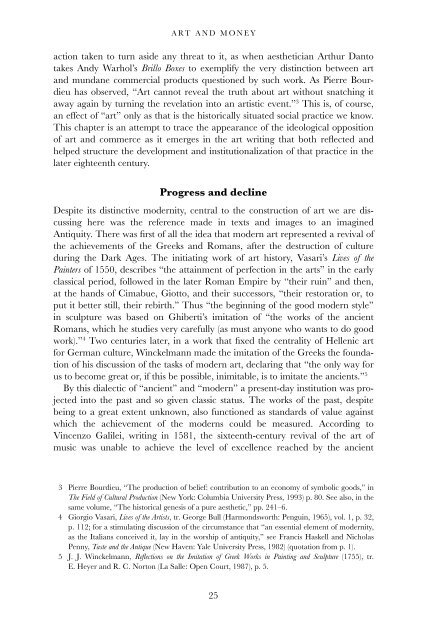Art in its Time: Theories and Practices of Modern Aesthetics
Art in its Time: Theories and Practices of Modern Aesthetics
Art in its Time: Theories and Practices of Modern Aesthetics
Create successful ePaper yourself
Turn your PDF publications into a flip-book with our unique Google optimized e-Paper software.
ART AND MONEY<br />
action taken to turn aside any threat to it, as when aesthetician <strong>Art</strong>hur Danto<br />
takes Andy Warhol’s Brillo Boxes to exemplify the very dist<strong>in</strong>ction between art<br />
<strong>and</strong> mundane commercial products questioned by such work. As Pierre Bourdieu<br />
has observed, “<strong>Art</strong> cannot reveal the truth about art without snatch<strong>in</strong>g it<br />
away aga<strong>in</strong> by turn<strong>in</strong>g the revelation <strong>in</strong>to an artistic event.” 3 This is, <strong>of</strong> course,<br />
an effect <strong>of</strong> “art” only as that is the historically situated social practice we know.<br />
This chapter is an attempt to trace the appearance <strong>of</strong> the ideological opposition<br />
<strong>of</strong> art <strong>and</strong> commerce as it emerges <strong>in</strong> the art writ<strong>in</strong>g that both reflected <strong>and</strong><br />
helped structure the development <strong>and</strong> <strong>in</strong>stitutionalization <strong>of</strong> that practice <strong>in</strong> the<br />
later eighteenth century.<br />
Progress <strong>and</strong> decl<strong>in</strong>e<br />
Despite <strong>its</strong> dist<strong>in</strong>ctive modernity, central to the construction <strong>of</strong> art we are discuss<strong>in</strong>g<br />
here was the reference made <strong>in</strong> texts <strong>and</strong> images to an imag<strong>in</strong>ed<br />
Antiquity. There was first <strong>of</strong> all the idea that modern art represented a revival <strong>of</strong><br />
the achievements <strong>of</strong> the Greeks <strong>and</strong> Romans, after the destruction <strong>of</strong> culture<br />
dur<strong>in</strong>g the Dark Ages. The <strong>in</strong>itiat<strong>in</strong>g work <strong>of</strong> art history, Vasari’s Lives <strong>of</strong> the<br />
Pa<strong>in</strong>ters <strong>of</strong> 1550, describes “the atta<strong>in</strong>ment <strong>of</strong> perfection <strong>in</strong> the arts” <strong>in</strong> the early<br />
classical period, followed <strong>in</strong> the later Roman Empire by “their ru<strong>in</strong>” <strong>and</strong> then,<br />
at the h<strong>and</strong>s <strong>of</strong> Cimabue, Giotto, <strong>and</strong> their successors, “their restoration or, to<br />
put it better still, their rebirth.” Thus “the beg<strong>in</strong>n<strong>in</strong>g <strong>of</strong> the good modern style”<br />
<strong>in</strong> sculpture was based on Ghiberti’s imitation <strong>of</strong> “the works <strong>of</strong> the ancient<br />
Romans, which he studies very carefully (as must anyone who wants to do good<br />
work).” 4 Two centuries later, <strong>in</strong> a work that fixed the centrality <strong>of</strong> Hellenic art<br />
for German culture, W<strong>in</strong>ckelmann made the imitation <strong>of</strong> the Greeks the foundation<br />
<strong>of</strong> his discussion <strong>of</strong> the tasks <strong>of</strong> modern art, declar<strong>in</strong>g that “the only way for<br />
us to become great or, if this be possible, <strong>in</strong>imitable, is to imitate the ancients.” 5<br />
By this dialectic <strong>of</strong> “ancient” <strong>and</strong> “modern” a present-day <strong>in</strong>stitution was projected<br />
<strong>in</strong>to the past <strong>and</strong> so given classic status. The works <strong>of</strong> the past, despite<br />
be<strong>in</strong>g to a great extent unknown, also functioned as st<strong>and</strong>ards <strong>of</strong> value aga<strong>in</strong>st<br />
which the achievement <strong>of</strong> the moderns could be measured. Accord<strong>in</strong>g to<br />
V<strong>in</strong>cenzo Galilei, writ<strong>in</strong>g <strong>in</strong> 1581, the sixteenth-century revival <strong>of</strong> the art <strong>of</strong><br />
music was unable to achieve the level <strong>of</strong> excellence reached by the ancient<br />
3 Pierre Bourdieu, “The production <strong>of</strong> belief: contribution to an economy <strong>of</strong> symbolic goods,” <strong>in</strong><br />
The Field <strong>of</strong> Cultural Production (New York: Columbia University Press, 1993) p. 80. See also, <strong>in</strong> the<br />
same volume, “The historical genesis <strong>of</strong> a pure aesthetic,” pp. 241–6.<br />
4 Giorgio Vasari, Lives <strong>of</strong> the <strong>Art</strong>ists, tr. George Bull (Harmondsworth: Pengu<strong>in</strong>, 1965), vol. 1, p. 32,<br />
p. 112; for a stimulat<strong>in</strong>g discussion <strong>of</strong> the circumstance that “an essential element <strong>of</strong> modernity,<br />
as the Italians conceived it, lay <strong>in</strong> the worship <strong>of</strong> antiquity,” see Francis Haskell <strong>and</strong> Nicholas<br />
Penny, Taste <strong>and</strong> the Antique (New Haven: Yale University Press, 1982) (quotation from p. 1).<br />
5 J. J. W<strong>in</strong>ckelmann, Reflections on the Imitation <strong>of</strong> Greek Works <strong>in</strong> Pa<strong>in</strong>t<strong>in</strong>g <strong>and</strong> Sculpture (1755), tr.<br />
E. Heyer <strong>and</strong> R. C. Norton (La Salle: Open Court, 1987), p. 5.<br />
25
















